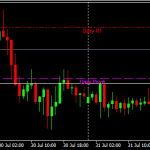- USDJPY jumps to ten week highs after a big positive surprise from the NFP job data released earlier today. The pair upward trend accelerated after earlier
USDJPY jumps to ten week highs after a big positive surprise from the NFP job data released earlier today. The pair upward trend accelerated after earlier on the week breached above the 100-day moving average. Japanese Yen feels the pressure as the risk on sentiment came back strong on hopes of a fast recovery in the global economy.
Nonfarm Payrolls Beat Estimates
The U.S. Nonfarm Payrolls increased by 2,5 million in May, smashing the expectations of -8 million jobs loss. The unemployment rate dropped to 13.3% while the forecast were looking for an increase to 20%. The Average Hourly Earnings came in at 6.7%, below the forecasts of 8.5% while the Labor Force Participation Rate rose to 60.8% in May from 60.2%.
From Japan, the Leading Economic Index came in at 76.2 below the expectations of 80.5 in April. The Coincident Index came in at 81.5 also below the expectations of 90.3.
Download our Q2 Market Global Market Outlook
USDJPY Price Support and Resistance
USDJPY is 0.61% higher at 109.66 as the rebound from the March lows continues and gains momentum above the 100-day moving average. The technical picture is bullish now for the pair, but the RSI index is in overbought territory, and a sharp correction can’t be ruled out.
On the upside, initial resistance for the USDJPY pair stands at 109.84 the daily top. The next resistance will be met at 110.60 the high from March 26. The next hurdle will be met at 111.71 the high from March 25.
On the flip side, first support for USDJPY pair will be met at 109.17 today’s low. If the pair breaks lower, the next support will be reached at 108.65 the low from yesterday’s trading session. If the selling pressure accelerates, the next support area will be met at 108.37 the 100-day moving average.





